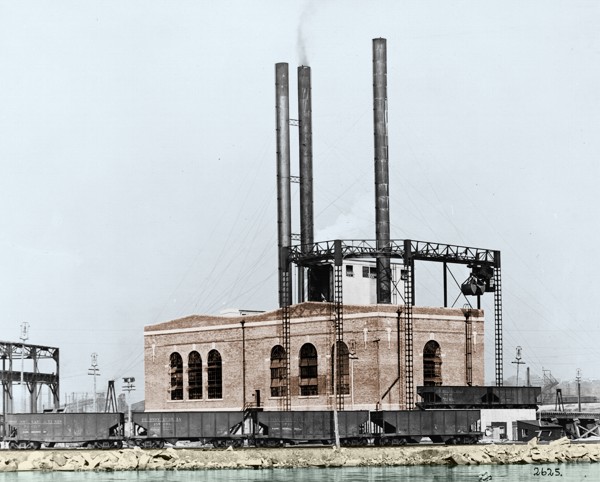The power behind the machinery |
|
The first Hulett Iron-ore Unloaders, in Conneaut, were steam-powered. When the electrically-operated Huletts were installed on what was the Pennsylvania Railroad Ore Dock in 1912, they needed a source of power. Specifically, 250 volts DC at 4,000 amperes. In 1912, utility power was not a viable option. There wasn't enough available, and what there was was not reliable. So building and operating a power plant just for the ore dock was a neccessity. (Later, as utility power became more available and reliable, the boiler half of the power house was torn down and the steam turbines and generators replaced with rotary AC to DC converters.)
 The total current draw of all motors on the four Hulett Unloaders plus the Ore Bridge would have been 15,000 amperes, if all motors were running at maximum load simultaneously. However that condition never did and never could occurr. Thus a 4,000-ampere power source was sufficient. The power house was capable of producing 6,000 amps from three generators, so there was enough redundancy to allow the four Huletts and the Ore Bridge to operate on two generators if necessary while the third was out of service.
The total current draw of all motors on the four Hulett Unloaders plus the Ore Bridge would have been 15,000 amperes, if all motors were running at maximum load simultaneously. However that condition never did and never could occurr. Thus a 4,000-ampere power source was sufficient. The power house was capable of producing 6,000 amps from three generators, so there was enough redundancy to allow the four Huletts and the Ore Bridge to operate on two generators if necessary while the third was out of service.
The load presented by the Huletts could vary widely. An idle Hulett would have no motors running and draw only a small current. But when lifting 17 tons of ore, the load could peak out at about 2000 amps for perhaps 15 seconds. The worst-case scenario would be four Huletts operating in unison, an unlikely condition but one that could peak at 8000 amps, twice than the maximum capacity of two turbine-generators. Because of the wide swings in load, the worst case being from zero to maximum and back to zero in minutes, the power system included an equalizer -- an energy storage device to deliver power on sudden demand when the steam turbines couldn't react quickly enough, and to store power when the load suddenly dropped and the turbines couldn't throttle back rapidly enough. Energy was stored in a large flywheel attached to a motor/generator. When the voltage rose above 250 volts, the motor/generator would speed up, putting excess energy into the flywheel. If it dropped below 250 volts, the motor/generator would draw energy from the flywheel. The goal was to stabilize the voltage caused by rapid changes in load to within plus or minus ten percent of 250 volts. One energy-storage flywheel served the entire plant.
Read a contemporary article detailing the unique features of the power house. (Courtesy Google Books)
Click HERE for a diagram of the power system.
 The total current draw of all motors on the four Hulett Unloaders plus the Ore Bridge would have been 15,000 amperes, if all motors were running at maximum load simultaneously. However that condition never did and never could occurr. Thus a 4,000-ampere power source was sufficient. The power house was capable of producing 6,000 amps from three generators, so there was enough redundancy to allow the four Huletts and the Ore Bridge to operate on two generators if necessary while the third was out of service.
The total current draw of all motors on the four Hulett Unloaders plus the Ore Bridge would have been 15,000 amperes, if all motors were running at maximum load simultaneously. However that condition never did and never could occurr. Thus a 4,000-ampere power source was sufficient. The power house was capable of producing 6,000 amps from three generators, so there was enough redundancy to allow the four Huletts and the Ore Bridge to operate on two generators if necessary while the third was out of service.